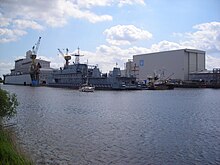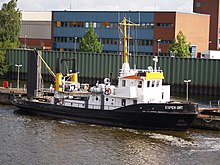Rostock naval command
The Rostock Marine Command , also known as the Eastern Marine Command , was a command of the Bundeswehr in which the units and associations of the former People's Navy of the GDR were combined after German reunification in 1990. It was set up on October 3, 1990 and disbanded on December 20, 1994 under conversion into the Naval Section Command East .
Mission and objectives
The order of the Rostock naval command was to manage the parts of the People's Navy that had been taken over on October 3, 1990, to reduce them and to transfer them to a target structure within the organization of the Bundeswehr .
The target structure was not yet fixed in 1990, so that the restructuring initially had to be based on preliminary framework specifications. This included the upper limit of 370,000 soldiers agreed in the two-plus-four contract , to which the Bundeswehr had to be reduced by 1994. The Bundeswehr's personnel in the new federal states should be 50,000, of which 40,000 were in the army , 8500 in the air force and 1,500 in the navy. The acceptance of material was only intended in exceptional cases.
organization
guide
The Rostock Marine Command was initially subordinate to the East German Army Command in Strausberg . From April 1991 it was subordinated to the naval support command in Wilhelmshaven . It was led by a commander from the German Navy with the rank of flotilla admiral , who was initially advised by the last chief of the People's Navy, Vice Admiral Hendrik Born .
| No. | Rank | Surname | from | to | Remarks |
|---|---|---|---|---|---|
| 2 | Flotilla admiral | Otto H. Ciliax | April 1, 1991 | December 20, 1994 | |
| 1 | Flotilla admiral | Dirk Horten | 3rd October 1990 | March 31, 1991 | Detached from the post of Deputy Commander of the Naval Support Command |
Initial structure
The structures of the People's Navy were initially adopted in 1990. This included three flotillas , a coastal missile regiment , a coastal defense regiment , a communications regiment , a naval helicopter group , schools and depots. On October 3, 1990, the number of NVA personnel was 8,325 soldiers and 3,700 civil servants.
Takeover organization
The first command, which began on October 3, 1990 with the takeover of the Volksmarine, consisted of 85 soldiers and 15 officers from the Bundeswehr. The Volksmarine command, now the Rostock Marine Command, the 4th Flotilla in Rostock-Hohe Düne and the officers' college in Stralsund received a new commander from the Federal Navy. The other units and associations retained their previous leadership, each with a Western advisory group.
Restructuring in 1991
In anticipation of a target structure to be defined later for the Navy in the accession area, an initial basic structure with the following elements was ordered:
- Rostock naval command
- 1 naval base command in Warnemünde
- 2 naval transport battalions
- 2 marine tracking points
- 1–2 marine telecommunications stations
- several depots
- 1 SAR branch in Parow
- 1 Coast Guard Squadron (limited until the end of 1991)
- 1 school (able to work from 1996/97)
Structure until 1994
Up until the transfer of the naval command to the eastern naval section command on January 1, 1995, the structure was adjusted several times. At the end of 1993 the following organization existed:
- Rostock naval command
- Naval base command Warnemünde
- Naval base command Peenemünde
- Marine Security Battalion 3
- Naval Transport Battalion 3rd
- Marine material depot 3
- Naval ammunition depot 5
- Marine material detachment depot
- Marine communications section 3
- Marine Telecommunication Company 31
- Marine Telecommunication Company 32
- Naval aviation helicopter group
In addition, there were other naval offices in the area of the Rostock naval command, which were subordinate to the fleet command and the naval office.
Further use of units and material
Vehicles taken over
For a while, a small number of ships and boats of the People's Navy were kept in service and carried a NATO ID :
- 2 frigates (coastal defense ships) of the Koni class : Rostock (F 224) and Halle (F 225)
- 1 speedboat the Sassnitz- class : Sassnitz (P 6165)
- 1 Tarantul class speedboat : Hiddensee , (ex Rudolf Egelhofer ) (P 6166)
- 5 -submarine boats of Parchim class : Grevesmühlen (P 6164), Gadebusch (P 6167), Teterow (P 6168), Lübz (P 6169) and Wismar (P 6170)
- 6 minesweepers of the Kondor II class : Tangerhütte (M 2669), Sömmerda (M 2670), Eisleben (M 2671), Bitterfeld (M 2672), Bernau (M 2673) and Eilenburg (M 2674)
- 6 barges of the Ohre class : Vogtland (Y 890), Altmark (Y 891), Havelland (Y 892), Uckermark (Y 893), Börde (Y 894), Wische (ex- Harz ) (Y 895)
- 9 tugs : Ummanz (Y 1650), Koos (Y 1651), Havel (Y 1654), Zingst (Y 1655), Wustrow (Y 1656), Thale (Y 1459), Dranske (Y 1658), Warnow (Y 1659) , Saale (Y 1660)
- 2 tankers : Kölpinsee (Y 1652), Fleesensee (Y 1657)
- 5 supply ships of the Darss class : Darss (A 1432), cooling (A 1433), Wittow (A 1430), Werdau (A 1434), Mönchgut (A 1431)
- 1 navigation mark control boat : Kolliker Ort (Y 1653)
Not all of these ships were used at sea. While all combat units were retired in the course of 1991, some auxiliary ships were permanently taken over into the service of the Bundeswehr.
The non-active vehicles were for the most part at the base Peenemunde launched and later sold, distributed free of charge or scrapped.
Coast Guard Squadron
In Warnemünde, formerly the base of the 4th Flotilla , a coast guard squadron consisting of up to twelve combat units was set up. It consisted of two frigates, some minesweepers, speedboats and submarines, which were kept in service in order to be able to demonstrate them to potential buyers in working order. The squadron's tasks were training and presence off the German coast. The workforce was limited to 500 soldiers. The squadron was decommissioned in late 1991.
Navy helicopter group
The naval helicopter group was stationed in Parow at the site of the former naval helicopter squadron 18 "Kurt Barthel" . She was up to 27 helicopters of the type Mil Mi-8 (NATO code hip ) and Mil Mi-14 (NATO reporting Haze ) times the largest helicopter Association of Marine. Her tasks included air transport as a shuttle between Kiel , Rostock , Wilhelmshaven and Flensburg . The naval helicopter group flew over 8,000 flight hours until it was decommissioned in late 1994. From 1992, the new building of the marine technology school was built on the site of the Parow naval air base .
Security troops
The Marine Security Battalion 3 in Rostock was formed from parts of the Coastal Defense Regiment 18 . It was later moved to Seeth in Schleswig-Holstein and has since been absorbed by the naval protection forces.
References
See also
literature
- Michael Kämpf: November 9, 1990 . In: Marineforum 11/2009, p. 34 ff.
- Stephan Huck, Hartmut Klüver (Ed.): The turn. The German Navy on the way to unification . Small series of publications on military and naval history Volume 13 ( ISSN 1617-3074 ) winklerverlag.com (PDF; 1.7 MB)
- Werner Rahn : German navies in transition: from a symbol of national unity to an instrument of national security . 2005
Individual evidence
- ↑ a b c Michael Kämpf: November 9, 1990 . In: Marineforum 11/2009, p. 34 ff.
- ↑ Dirk Horten: The German Unity. Findings as the first commander of the Rostock naval command . In: Stephan Huck, Hartmut Klüver (Hrsg.): The turn . P. 31 ff.
- ↑ Navy on course 2005. The Navy in Mecklenburg-Western Pomerania . In: Marineforum 10-1993 p. 362 f.
- ↑ List of ship numbers of the BWB 2002 ( Memento of the original from March 4, 2016 in the Internet Archive ) Info: The archive link was inserted automatically and has not yet been checked. Please check the original and archive link according to the instructions and then remove this notice. (PDF; 471 kB)
- ↑ Wolfgang Henze: Aviation Safety Cup goes to the new federal states for the first time . In: Marineforum 6/1994, p. 214 f.
Remarks
- ↑ The preliminary working term for the command was naval deployment command . The terms Marine Command Rostock and Marine Command East both appear, whereby the sources cited here, which were written by employees and commanders of the command, speak of the Rostock Marine Command. Therefore this term was chosen as a lemma.




